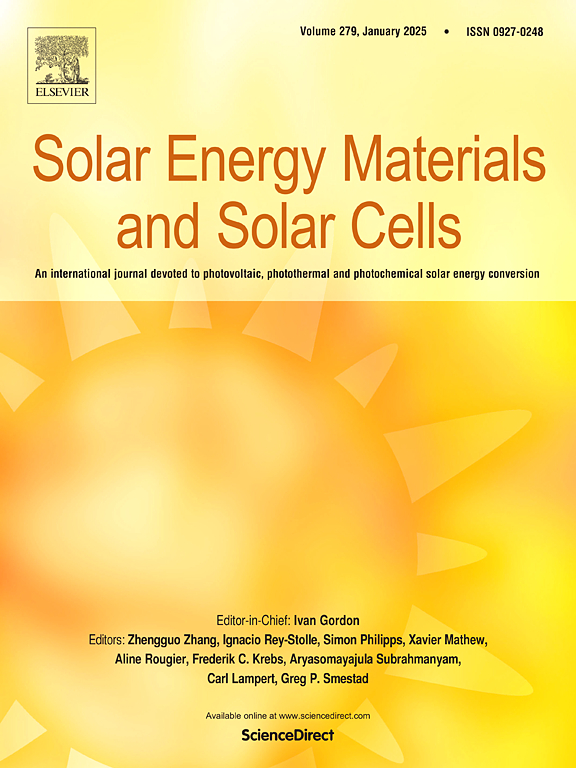Efficiency improvement and microstructural working principle of LECO on the n-TOPCon rear side of industrial-like TOPCon solar cells
IF 6.3
2区 材料科学
Q2 ENERGY & FUELS
引用次数: 0
Abstract
Laser-enhanced contact optimization (LECO) generating current-fired contacts (CFC) is one of the key technologies for production of high-efficiency industrial TOPCon solar cells. Its microstructural working principle on PERC solar cells is well-known and has recently been reported for the diffused boron emitter front side of industrial TOPCon solar cells. However, detailed n-TOPCon rear side specific investigations of the LECO process on contact properties are missing. In this contribution, we close that gap by first providing comprehensive performance data of TOPCon cells with diffused boron emitter front side and n-TOPCon rear side as industrial-like model samples. Second, we were able to identify current-fired contacts on n-TOPCon layers and investigate their nanostructure by employing a contrast etching technique, developing a large-area cross-section preparation approach and an adapted FIB preparation protocol. It becomes apparent that the contact formation significantly differs from non-LECO TOPCon contacts. Thirdly, we show that the efficiency improvement of the cells due to LECO is driven by reduction of Ag/poly-Si contact resistance and that LECO may lead to severe degradation of passivation quality if not optimized properly. Based on our findings, we developed a microstructural model of the working principle of LECO on n-type TOPCon layers.
工业型TOPCon太阳能电池n-TOPCon背面LECO的效率提升及微结构工作原理
激光增强触点优化(LECO)产生电流燃烧触点(CFC)是生产高效工业TOPCon太阳能电池的关键技术之一。它在PERC太阳能电池上的微结构工作原理是众所周知的,最近被报道用于工业TOPCon太阳能电池的扩散硼发射器正面。然而,详细的n-TOPCon背面LECO工艺对接触特性的具体研究还缺失。在这篇论文中,我们首先提供了具有扩散硼发射器正面和n-TOPCon背面的TOPCon电池的综合性能数据,作为工业模型样本,从而缩小了这一差距。其次,我们能够识别n-TOPCon层上的电流激发触点,并通过采用对比蚀刻技术研究其纳米结构,开发了大面积横截面制备方法和适应性FIB制备方案。很明显,触点的形成与非leco的TOPCon触点有很大的不同。第三,我们发现由于LECO导致的电池效率的提高是由Ag/多晶硅接触电阻的降低驱动的,如果LECO优化不当,可能会导致钝化质量的严重下降。基于我们的发现,我们建立了n型TOPCon层上LECO工作原理的微观结构模型。
本文章由计算机程序翻译,如有差异,请以英文原文为准。
求助全文
约1分钟内获得全文
求助全文
来源期刊

Solar Energy Materials and Solar Cells
工程技术-材料科学:综合
CiteScore
12.60
自引率
11.60%
发文量
513
审稿时长
47 days
期刊介绍:
Solar Energy Materials & Solar Cells is intended as a vehicle for the dissemination of research results on materials science and technology related to photovoltaic, photothermal and photoelectrochemical solar energy conversion. Materials science is taken in the broadest possible sense and encompasses physics, chemistry, optics, materials fabrication and analysis for all types of materials.
 求助内容:
求助内容: 应助结果提醒方式:
应助结果提醒方式:


